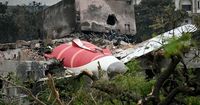India is grappling with the aftermath of one of the deadliest aviation disasters in its history as investigators continue to probe the tragic crash of Air India flight AI 171. The Boeing 787-8 Dreamliner, bound for London, crashed less than a minute after taking off from Ahmedabad airport in Gujarat on June 12, 2025, killing 260 people on board and another 19 on the ground. The catastrophe has sent shockwaves through the nation and the global aviation community, with officials now considering every possible cause—including the unprecedented possibility of sabotage.
The Aircraft Accident Investigation Bureau (AAIB) in New Delhi is leading the comprehensive investigation, working with multiple agencies and receiving technical assistance from international bodies such as the US National Transportation Safety Board (NTSB). Central to this probe is the analysis of the aircraft’s black boxes, officially known as Enhanced Airborne Flight Recorders (EAFRs). These bright orange devices, recovered from the crash site in mid-June, are crucial for piecing together the sequence of events that led to the disaster.
Unlike older aircraft that had separate cockpit voice recorders (CVR) and flight data recorders (FDR), the Boeing 787 is equipped with two combined units that record both flight data and cockpit sounds. The first EAFR was retrieved on June 13 from a building rooftop near the crash site, and the second was found on June 16 amid the wreckage. These recorders capture a staggering amount of information—up to 2,000 parameters including altitude, airspeed, heading, engine performance, and pilot communications, all stored for at least 25 hours of flight data and two hours of cockpit audio.
Preliminary reports indicate that the plane climbed to a mere 625 feet before losing altitude and crashing just 33 seconds after takeoff. Moments before impact, Captain Sumeet Sabharwal, 55, issued a desperate Mayday call to air traffic control, shouting, “No thrust... May Day... May Day.” This chilling transmission underscores the severity of the situation as both engines apparently lost power simultaneously—a phenomenon experts have described as a “one in a billion event.”
Given the rarity of such a simultaneous engine failure, investigators are exploring all possibilities, including mechanical malfunction, fuel supply issues, bird strikes, and, notably, sabotage. India’s Minister of State for Civil Aviation, Murlidhar Mohol, has publicly acknowledged that sabotage is being considered for the first time during the investigation. “The Aircraft Accident Investigation Bureau (AAIB) has begun a full probe. It is being assessed from all angles, including any possible sabotage,” Mohol said. He detailed that authorities are reviewing CCTV footage from Ahmedabad spanning the previous 30 days and scrutinizing passenger screening and passport records to uncover any suspicious activity.
The black box data, which has been downloaded and is currently under detailed examination at the AAIB laboratory in Delhi, is expected to yield critical insights. The flight data recorder will allow investigators to reconstruct the flight’s final moments through a computer-generated animation, showing the aircraft’s attitude, instrument readings, and power settings. Meanwhile, the cockpit voice recorder will reveal conversations between the pilots, background noises such as engine sounds, warning alarms, and other cockpit interactions that might shed light on what went wrong.
Importantly, the EAFRs on the Boeing 787 are equipped with independent emergency batteries capable of recording flight data for about ten minutes even in the event of a total electrical failure. Since the plane crashed within a minute of takeoff, this feature likely ensured that investigators have access to comprehensive data from the flight’s brief duration.
Despite speculation, the black boxes will remain in India for analysis. Minister Mohol emphasized, “It will not go anywhere. It is in AAIB’s custody, and there is no need to send it outside the country. We will carry out the entire investigation ourselves.” The final report on the crash is expected within three months, but experts caution that interpreting the complex data could take weeks, given the sophistication of modern aircraft systems and the possibility of multiple simultaneous failures.
The human toll of the crash is devastating. The flight carried 242 people—230 passengers, two pilots, and ten crew members. Tragically, only one passenger survived: Vishwash Ramesh, a 40-year-old British national from Leicester, who was seated in an emergency exit row. Ramesh escaped the mangled fuselage but suffered immense personal loss, as his brother Ajay, 35, was among those who perished. “I tried to get two seats together, but someone had already got one. Me and Ajay would have been sitting together. But I lost his brother in front of my eyes. So now I am constantly thinking ‘Why can't I save my brother?’” he shared, highlighting the profound grief that shadows the sole survivor.
The crash also claimed the lives of 19 individuals on the ground, including nine students and relatives residing in the hostel quarters of the B. J. Medical College in Ahmedabad, where the plane collided after losing altitude. The college was bustling with hundreds of students and staff having lunch at the time, amplifying the tragedy’s impact on the local community.
In response to public concern, Minister Mohol reassured travelers about the safety of air travel in India, especially on the country’s fleet of 33 Boeing 787 Dreamliners. “All 33 Dreamliners have been inspected on the orders of the Directorate General of Civil Aviation (DGCA). Everything was found safe. That is why I said it was a rare accident. People are no longer scared and are traveling comfortably,” he stated.
As investigators sift through mountains of data and evidence, the nation waits anxiously for answers. The AAIB’s meticulous work, aided by international expertise, aims to unravel the exact causes behind this unprecedented tragedy—whether mechanical failure, human error, or deliberate sabotage. For now, the black boxes hold the keys to unlocking the truth, promising a clearer picture of the fateful moments that led to the deadliest Indian airline crash in four decades and the first fatal accident involving the Boeing 787 Dreamliner.





